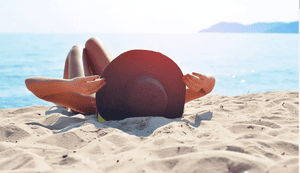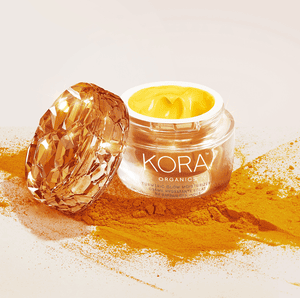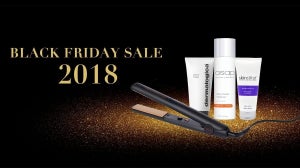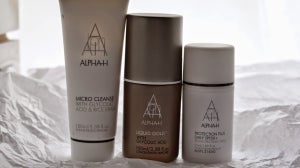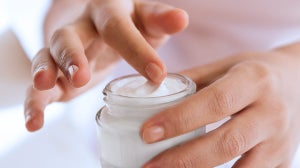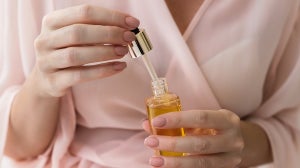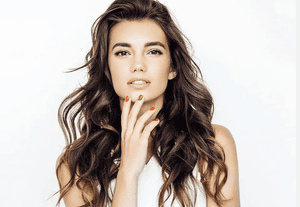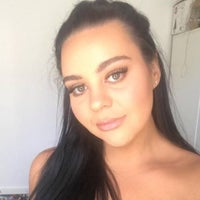
What Level Is Your Sunburn?
Sunburn can look different on every skin tone but in general the severity of the burn will be categorised as either first degree, second degree, or third degree.First degree sunburn is the most common and least severe. This level of burn is when there is damage to the outer layer of skin. This can look red, dry and tight but has no blisters. Although this burn is the least dangerous, it will still be painful to touch. First degree sunburn usually heals on its own within 3 to 6 days but Aruj Javid recommends using deep moisturising products such as after sunto speed up the process and minimise any pain.
Second degree burn is when it starts to get more serious. This level of burn is when the inner layer of skin has been damaged by the sun. This can hurt when you touch it and can leave blisters or thickening and swelling of the skin. This type of sunburn will typically heal within 7 to 21 days depending on the severity. You may also develop a scar where you have sunburnt. NAME recommends using Aloe Vera and aftersun applied generously and frequently, and also consulting your doctor if you suspect you have second degree burns.
Third degree burns are deeper than second degree burns and are far more severe. With this level of sunburn, you can expect to experience blisters and scarring. Aruj Javid highlights that if you suspect you have third degree burns, you must seek urgent medical attention, keep the burn clean and use antibiotic ointments and creams.
Regardless of your level of sunburn you should seek medical attention if you begin to experience any negative side effects. This can include but is not limited to blistering, high fever, headache, severe pain, dehydration, confusion, nausea or chills.Sunburn On Different Skin Tones
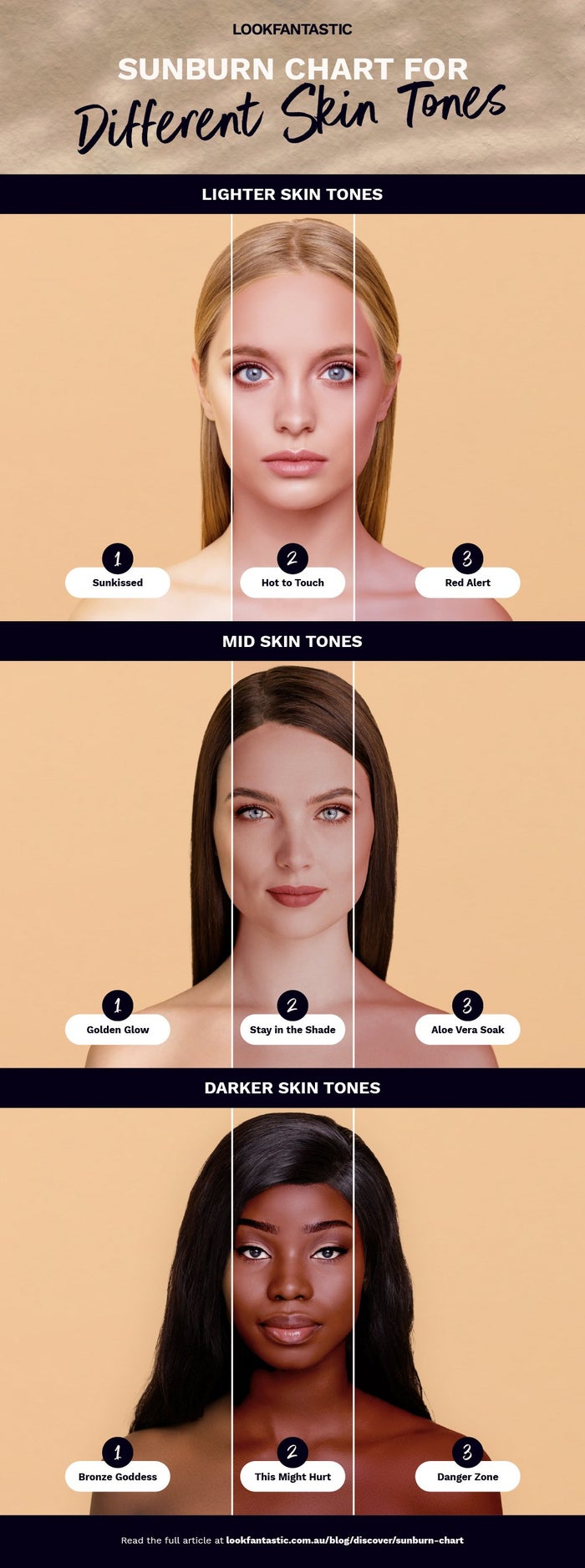
- Take a pain reliever such as ibuprofen.
- Cool the skin.
- Apply a moisturiser or Aloe Vera.
- Make sure to stay hydrated.
- If your skin is blistered, speak to your doctor and don’t pop your blisters unless advised by a GP.
- Treat peeling skin gently.
- Apply an anti itch or medicated cream.
- See a GP if you are experiencing high fever, headache, severe pain, dehydration, confusion, nausea or chills as a result of your sunburn.
- Go to the hospital if your sunburn is severe and causes you to have negative side effects.
How Sunburn can Impact your Skin
As part of our research, we’ve looked at some of the most common side effects that your skin might experience as a result of sunburn, and how is best to treat them.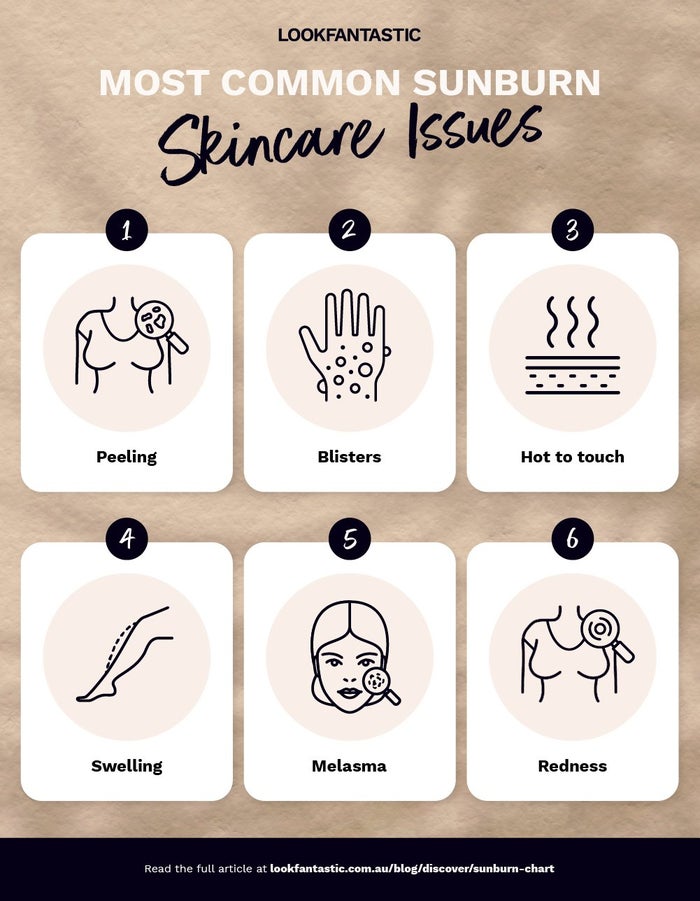
Redness
The most common side effect of sunburn on lighter skin tones is redness. Redness is an indication of your skin being irritated and this can appear as soon as 10 to 15 minutes after sun exposure. However, in some cases redness can take up to 12 hours to fully form, so it’s important you start to treat your sunburn as soon as possible.As a first step in treating your sunburn, keeping the area well moisturised can ease tightness and any pain, may help to reduce any redness. As well as this, taking anti inflammatory medication such as Ibuprofen can help lessen side effects from sunburn.Peeling
Peeling occurs when the body is trying to heal itself by getting rid of damaged cells. However, peeling your sunburn yourself or exfoliating the area can encourage the risk of infection, so try to leave your sunburnt skin alone.Peeling usually will stop after around 7 days for mild and moderate sunburn or when the sunburn is fully healed, if this continues, we advise you to consult with your doctor. Aruj Javid suggests using gentle products and making sure anything you are using on your sunburn is alcohol free as this will only dry out the area even more and irritate your burn.Blisters
Your body will create blisters on top of your sunburn to protect itself and allow the sunburn to heal without getting infected.Aruj Javid suggests not popping your blisters as it will then take your body longer to heal and leaves you at risk of developing an infection, however if they are to break on their own then clean the area with mild soap and cover the area with a wet dressing to prevent infection. Aruj Javid also recommends consulting your doctor if you start to develop blisters as a result of your sunburn.
Hot to touch
When you burn your skin it becomes inflamed which can cause your skin to feel hot. This is due to increased blood flow to the affected area.Aruj Javid suggests using a cold compress on the affected area to cool it down and lessen any discomfort.Swelling
When sunburn is more severe it can cause the area to swell which is usually accompanied by blisters. This is quite common with more serious burns, however if you experience a fever with chills, headaches, nausea and weakness then it's vital that you seek medical attention.Melasma
When our skin is exposed to sunlight it triggers our body to produce more melanin, which can then cause Melasma. This is when the skin develops patches of darker skin and is most common on your face and neck.Aruj Javid suggests using high SPF to prevent worsening of Melasma and using ingredients such as Vitamin C to reduce dark areas of pigmentation caused by Melasma.
Signs of Skin Cancer
Skin cancer can be a result of skin damage from sunburn. If at any point you are concerned about the level of your sunburn and the implications this may cause, we encourage you to consult with your doctor. The Cancer Council reports that Melanoma is the third most common cancer amongst Australians, and every year in Australia skin cancer accounts for around 80% of newly diagnosed cancers.
Common Signs of Skin Cancer
- New moles, these may also increase in size.
- An outline of a mole that becomes notched or have an uneven border
- A spot that changes colour from brown to black or is varied.
- A spot that becomes raised or develops a lump within it.
- The surface of a mole becomes rough, scaly or ulcerated.
- Moles that itch or tingle.
- Moles that bleed or weep.
- Spots that look different from the others.
Mole or Skin Cancer?
- Moles are generally harmless coloured spots that range from 1 mm to 10 mm.
- They are uniform in shape and even coloured. They may be raised.
- Moles may have uneven borders and multiple colours like brown and black.
For more information on how to check your moles please visit the Cancer Council’s website here.
Whether you have experienced sunburn or not, if you are concerned about a new or existing mole, please consult with your doctor.
Top ranking SPF Products
Wearing SPF is not only important to use all year round to protect your skin from UV damage, premature ageing and skin cancer, but it’s crucial to wear it in higher temperatures and hotter climates, especially those experienced in Australia. We’ve pulled together the top ranking SPF products to help protect your skin not just this summer, but all year round.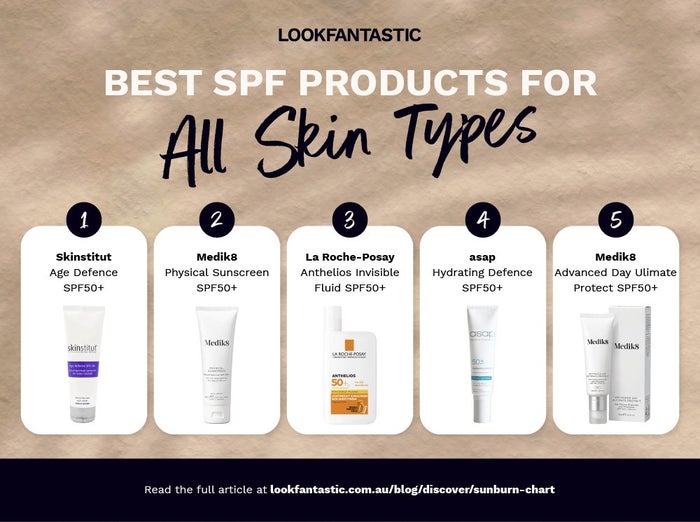
1. Skinstitut Age Defence SPF 50+ 75ml
This hybrid SPF moisturiser protects against UVA and UVB rays which cause premature ageing and skin damage, containing vitamin B3 for maximum hydration. If you are looking for a high protection SPF to stop you from developing signs of premature ageing then this ones for you!
2. Medik8 Physical Sunscreen SPF50+ 60ml
If you are worried about environmental aggressors ageing your skin along with premature ageing from sun damage then this SPF is for you. Rich in antioxidants, the innovative sunscreen is reinforced with anti-pollution, anti-infrared, and anti-glycation technologies to shield skin from environmental aggressors, this combined with the factor 50+ sun protection is certain to help prevent fine lines and wrinkles.
3. La Roche-Posay Anthelios Invisible Fluid SPF 50+ 50ml
This TikTok famous sun cream is perfect for those with normal to combination skin. The non-greasy fluid is suitable for use on fair and sensitive skin, helping to prevent the appearance of dark spots caused by the sun's harmful UVA and UVB rays. So if you are prone to sun spots or Melasma, this sun cream is for you!
4. asap Hydrating Defence SPF50+ 100ml
This formula contains Nicotinamide (Vitamin B3), Hyaluronic acid and Curcuma longa (Turmeric) to promote skin elasticity and calm redness. This hydrating formula is great for those with dry skin, so if that is one of your skin concerns then look no further!
5. Medik8 Advanced Day Ultimate Protect 50ml
The Medik8 Advanced Day Ultimate Protect doubles up as a day cream, moisturising and protecting your skin from sun damage. Elevated with next-generation DNA repair enzymes, this product offers an environment shield on your skin.
Hottest and Sunniest Australian Cities In Summer
Looking into the average hours of daylight, temperatures and UV level in Australian summer time, we have created an overall ranking of the hottest and sunniest Australian cities to show you where you are most likely to burn. This data has been pulled during 11am-1pm on cloud free days, which is when it is generally hottest and sunniest.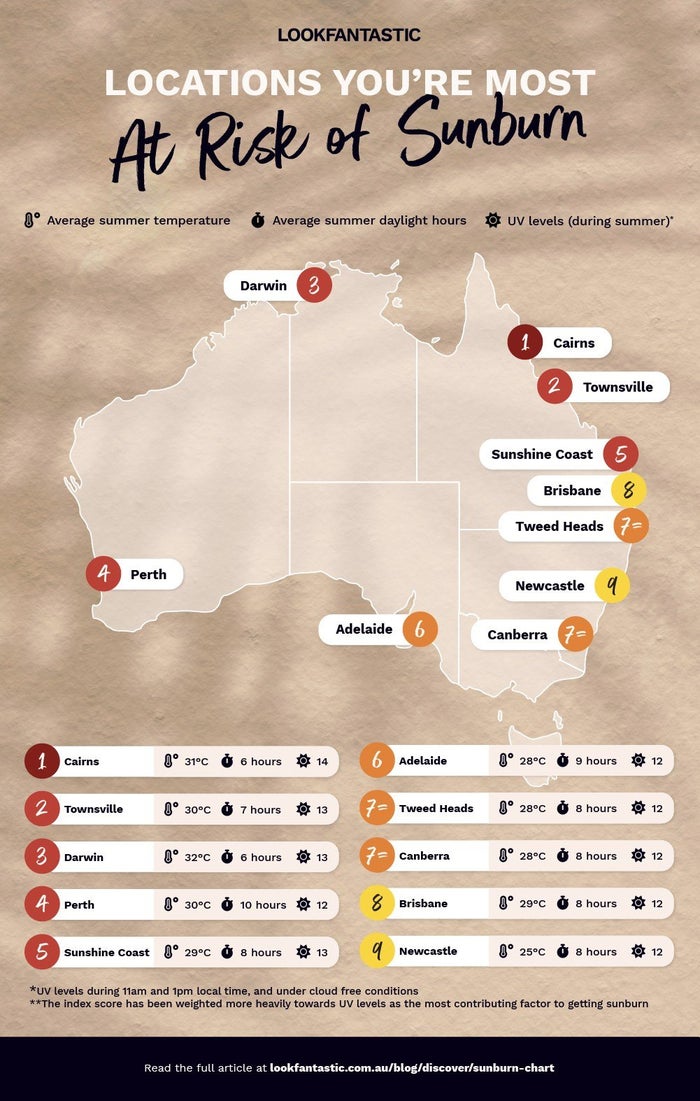
1. Cairns, North QueenslandFirst place is Cairns, considered the gateway to Australia's Great Barrier Reef, Cairns is a great location to spend your days this summer! Just off North Queensland, Cairns is a tropical city with a UV of 14! The average temperature in Cairns is 31 degrees and the average amount of daylight hours is 6.2. Townsville, North Queensland
Coming in second place is Townsville in Queensland. This coastal city has a UV level of 13, an average temperature of 30 degrees and an average of 7 hours of daylight during summer.3. Darwin, Northern Territory
In third place is Darwin in the Northern Territory. With several waterfront and beach areas, we have no doubt this location gets busy in the summertime! Darwin has a UV level of 13, an average temperature of 32 degrees and on average 6 hours of daylight.4. Perth, Western Australia
Perth has ranked fourth place. With an average temperature of 30 degrees, an average UV level of 12 and an average of 10 hours of daylight during summer, meaning Perth is one of the places you are most at risk of burning. So, if you are thinking of spending your summer in Perth, don’t forget your 50+ SPF because you are going to need it!5. Sunshine Coast, Queensland
At number five on the ranking is Sunshine Coast in Queensland. If the name didn’t give it a way Sunshine Coast has a whopping UV level of 13! It also has an average temperature of 29 degrees and an average of 8 hours of daylight during summer.6. Adelaide, South Australia
In sixth place is Adelaide in South Australia. With an average temperature of 28 degrees, an average UV level of 12 and an average of 9 hours of daylight during summer, Adelaide is going to be a hot one so make sure to cover up and protect your skin.7. Tweed Heads, Queensland, New South WalesAfter Adelaide is Tweed Heads in Queensland, New South Wales. This Australian city is going to be in desperate need of SPF this summer, with an average temperature of 28 degrees, an average UV level of 12 and an average of 8 hours of daylight during summer.8. Canberra, Australia Capital Territory, New South WalesNext is the capital city in joint seventh with Tweed Heads - Canberra in New South Wales! This city scored identical to Tweed Heads in every category, with an average temperature of 28 degrees, an average UV level of 12 and an average of 8 hours of daylight during summer.9. Brisbane, Capital of QueenslandComing in eigth place is the capital of Queensland, Brisbane. This city spans right across the river, so we know it will be a popular hangout this Summer! Brisbane has a UV level of 12, an average temperature of 31 degrees and a whopping 7.7 hours of daylight.10. Newcastle, New South WalesComing in ninth place is Newcastle in New South Wales. Being a harbour city with lots of beaches Cairns is a lovely city to spend your summer days. With a UV of 12, an average temperature of 25 and an average of 8 daylight hours in Summer, Cairns is a great spot to chill out this Summer, but don’t forget your SPF!
With Australian Summer time just around the corner we hope this study has not only taught you about how to treat your sunburn but also the importance of wearing SPF everyday! Not only does SPF protect you from sun damage, it also prevents signs of early ageing such as fine lines, wrinkles and pigmentation. So, if you are wanting to take care of your skin this summer then visit our SPF’s on site here.

Related Articles
